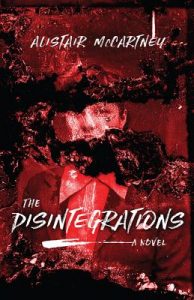 The Disintegrations
The Disintegrations
by Alistair McCartney
University of Wisconsin Press. 232 pages, $26.95
A SEMI-AUTOBIOGRAPHICAL meditation on death, Alistair McCartney’s The Disintegrations has the feeling of a conversation between new friends, exploring the idea of death through several stories. In fact, the narrator, also named Alistair McCartney, is rather obsessed with death. He teaches at a college in Los Angeles directly across from a cemetery, so he looks at “death” almost every day. He frequently walks around the grounds, at one point watching a funeral in progress. He meets a young man at the cemetery and talks with him. His new friend encourages McCartney to spend the night with him among the gravestones, but he thinks twice about it and runs away.







